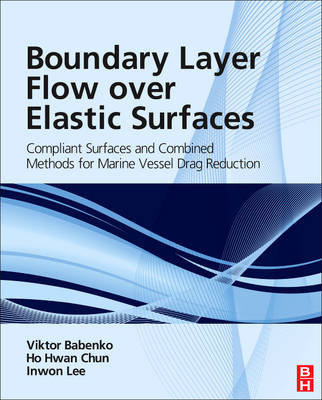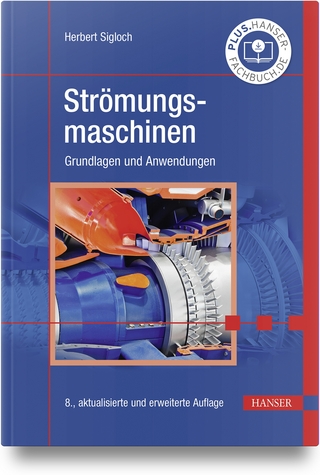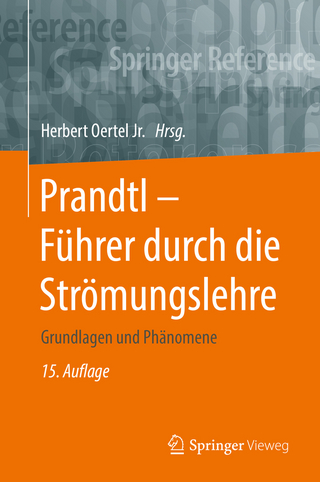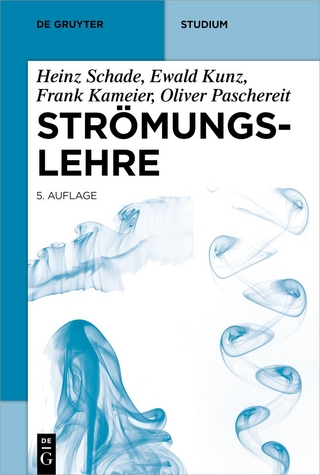
Boundary Layer Flow over Elastic Surfaces
Butterworth-Heinemann Inc (Verlag)
978-0-12-394806-9 (ISBN)
While other methods of drag reduction are well-known in marine R&D and ship design environments worldwide, compliant coating drag reduction remains less well-known and poorly understood. This important book presents cutting-edge techniques and findings from research sources not generally accessible by Western researchers and engineers, aiding the application and further development of this potentially important technology.
Beginning with an introduction to drag reduction that places the authors’ work on elastic surfaces and combined techniques in context, the book moves on to provide a comprehensive study of drag reduction through elastic coating with both flow and material properties considered. Coverage includes:
Experimental findings around coherent vortical structures (CVS) in turbulent boundary layers and methods of controlling them
Static and dynamic mechanical characteristics of elastic composite coatings, as well as new techniques and devices developed for their measurement
Combined methods of flow control and drag reduction, including the effect of injection of polymer solutions, elastic coatings and generated longitudinal vortical structures on hydrodynamic resistance
Intended as a reference for senior engineers and researchers concerned with the drag reduction and the dynamics of turbulent boundary layer flows, Boundary Layer Flow over Elastic Surfaces provides a unique source of information on compliant surface drag reduction and the experimental techniques around it that have shown measurable and repeatable improvements over recent years.
This compilation of research findings and new techniques developed for measurement will aid R&D engineers, naval architects and senior designers in their quest to achieve drag reductions that will deliver significant efficiency savings.
Prof. Viktor V. Babenko received his MSc in Mechanical Engineering from the Moscow Aviation Institute in 1963 and his PhD in Fluid and Gas Mechanics from the Institute of Hydro-aeromechanics of the National Academy of Sciences of Ukraine (NASU) in 1970. Between 1963 and 1965, he worked at the Antonov Design Bureau, a Ukrainian aircraft manufacturing company. He has been at the Institute of Hydromechanics since 1965, where he has managed research projects on boundary layers. He has been a professor since 1990, and was the Head of Department until 2000. Throughout his career, he has developed original methodologies for research on boundary layer receptivity to 2D and 3D disturbances, at flows around elastic coatings, near different cavities and ledges, in a vortex chamber, at movement of high-speed surface devices, and others. He has developed control methods for coherent vortical structures arising at various types of flows. From 1989 to 2006, he was a member of the Scientific Council of the Institute of Hydromechanics NASU, and since 2000 he has been a member of the Scientific Councils of the Universities of Civil Aviation and Polytechnic in Kiev. BSc and MSc, Dept. of Naval Architecture & Ocean Engineering, Pusan National University,Korea (1983,1985)Ph.D., Dept. of Naval Architecture & Ocean Engineering, Glasgow University, U.K. (1988)Professor at Dept of Naval Architecture & Ocean Engineering(1994~present)Director of Advanced Ship Engineering Research Center(2002~present)Senior Researcher of Hyundai Maritime Research Institute 1991~1993:Yard Research Fellow, Glasgow University, U.K. 1988~1991Member of 25, 26th ITTC Resistance Committee (2005~present)Member of 24th ITTC Waterjet Specialist Committee (2002~2005)Member of 22th ITTC Safety of High Speed Marine Vehicles Specialist Committee(1996~1999)Fellow of Royal Institute of Naval Architects(UK) (2001~present)Member of SNAME(USA)Member of SNAK(Korea)Deputy Editor of Journal of Marine Science Technology (published by Springer)(2006~2009)Editor of International Journal of Naval Architecture & Ocean Engineering (2009~present) CareerMarch 2000 ~ May 2000; Post Doctoral ResearcherMechanical Engineering Research Institute,KAIST (Korea Advanced Institute of Science and Technology), Daejeon, KoreaJune 2000 ~ May 2001; JSPS Postdoctoral FellowDivision of Mechanical Science, Graduate School of Engineering,Hokkaido University, Sapporo, JapanJune 2001 ~ September 2003; Senior ResearcherCore Technology Group, Digital Appliance Laboratory,LG Electronics, Seoul, KoreaOctober 2003 ~ February 2008; Assistant ProfessorASERC (Advanced Ship Engineering Research Center),Pusan National University, Busan, KoreaMarch 2008 ~ Present; Associate ProfessorASERC (Advanced Ship Engineering Research Center),Pusan National University, Busan, KoreaMarch 2011 ~ Present; Visiting ScholarDept. of Mechanical Engieering,University of Michigan, Ann Arbor, MI, USAProfessional Society Activities- Member, Korean Society of Mechanical Engineers, March 1994 ~ Present- Member, Korean Society of Visualization, December 2001 ~ Present- Member, Society of Naval Architects of Korea, January 2004 ~ Present- Business Director, Korean Society of Visualization, March 2006 ~ Present- Member, Korea Towing Tank Committee, March 2008 ~ PresentResearch Projects- PI (Principal Investigator), Effects of riblets on the streaky structures excited by free stream tipvortices in boundary layer, March 2003 ~ September 2004, USD5,000, Pusan National University- PI, Development of Design and Evaluation Technique of Compliant Coating for Ship DragReduction, April 2004 ~ March 2006, Korea Research Foundation- PI, Ship Skin Friction Reduction Technique (I), March 2005 ~ February 2008, Korea Science andEngineering Foundation- PI, Development of Boundary Layer Skin Friction Reduction Technology Using Compliant Coating,March 2005 ~ February 2007, Samsung Heavy Industries Co., Ltd.- PI, Experimental Test for ROV Thrust, October 2006 ~ December 2006, Daewoo Shipbuilding andMarine Engineering Co., Ltd.- PI, Course-Keeping Model Test of a 83M Class Flat Barge, March 2007 ~ April 2007, HyundaiTechnology Inc.- PI, Towing Tank Experiment for ROV Resistance and Thrust Performance, April 2007~ July 2007,Daewoo Shipbuilding and Marine Engineering Co., Ltd.- PI, Hull Design and Towing Tank Experiment for 16,000 DWT General Cargo Ship, May 2007~July 2007, Mariso Inc.- PI, Assessment of Skin Friction Reduction Performance of Silicone Polyurea Marine Paint, May2007~ April 2008, Institute of Technology Evaluation and Planning- PI, Towing Tank Experiment of LST-II, September 2007~ November 2007, Hanjin Heavy IndustriesCo., Ltd.- PI, Towing Tank Model Test for Oceanographic Research Vessel, October 2007 ~ December 2007,Far East Ship Design & Eng. Co., Ltd.- PI, Towing Tank Model Test for 34K Bulk Carrier, November 2007 ~ March 2008, JHME Co. Ltd.- PI, Towing Tank Experiment for Hull Cleaning ROV Resistance and Thrust Performance, February2008 ~ April 2008, Daewoo Shipbuilding and Marine Engineering Co., Ltd.- PI, Research on the Skin Friction Reduction of Submarine using Compliant Coating Technology,March 2008 ~ November 2008, Republic of Korea Navy- PI, Optimization of skin friction reduction mechanism of silicone polyurea material, August 2008~July 2010, Korea Research Foundation- PI, Evaluation of Erosion Resistance and Cavitation Suppression Effect of Si-Polyurea RudderCoating, August 2008 ~ July 2010, Small & Medium Business Administration- PI, Underwater Performance Test of the Deep Sea Camera Platform, December 2008, DaewooShipbuilding and Marine Engineering Ltd.- PI, Towing tank model test for 20m class service boat (SB-A), March 2009 ~ May 2009, KangnamCo. Ltd.- PI, Towing Tank Experiment for Hull Cleaning ROV Resistance and Thrust Performance, April 2009~ June 2009, Daewoo Shipbuilding and Marine Engineering Co., Ltd.- PI, Study on the Resistance Performance of Various Antifouling Marine Paints, April 2009 ~October 2009, Samsung Heavy Industries Co., Ltd.- PI, Towing tank model test for 30m class rescue boat, May 2009 ~ June 2009, P&P Korea Co., Ltd.- PI, Towing tank model test and seakeeping analysis for 170ton class oceanographic research vessel,June 2009 ~ July 2009, Far East Ship Design & Eng. Co., Ltd.- PI, Towing tank model test for 13k deck cargo vessel, October 2009 ~ December 2009, PT. JAYASAMUDRA KARUNIA SHIPPING- PI, Towing tank model test for 3.6k DWT Molten Sulfur Carrier, December 2009 ~ February 2010,Far East Ship Design & Eng. Co., Ltd.- PI, Study on the Effect of Fouling on the Various Marine Coating Surfaces on the ResistancePerformance, April 2010 ~ December 2010, Samsung Heavy Industries Co., Ltd.- PI, Towing Tank Model Test for 10k DWT Self Unloading Coal Carrier, June 2010 ~ August 2010,Oriental Precision & Eng. Co.- PI, Towing Tank Model Test for 48k Bulk Carrier, October 2010 ~ January 2011, Win ENG Inc.- PI, Towing tank skin friction test for various antifouling paints, October 2010 ~ December 2010,KCC Ltd.- PI, Towing Tank Model Test for 19k Heavy Duty Cargo Carrier, December 2010 ~ February 2011,Samho Hitech Co. Ltd.
PrefaceList of Symbols1. Interaction of the Free Stream with an Elastic Surface2. Types of Elastic Surfaces and Research of their Mechanical Characteristics3. Turbulent Boundary Layer over Elastic Plate4. Fluctuations of an Elastic Surface in Turbulent Boundary Layer5. Experimental Investigation of Friction Drag6. Hydrobionic meaning of the anatomy of fast swimming hydrobionts7. Mathematical modeling of turbulent boundary layer with injection of polymer additivesReferences
| Verlagsort | Woburn |
|---|---|
| Sprache | englisch |
| Maße | 191 x 235 mm |
| Gewicht | 1300 g |
| Themenwelt | Naturwissenschaften ► Physik / Astronomie ► Strömungsmechanik |
| Technik ► Fahrzeugbau / Schiffbau | |
| Technik ► Maschinenbau | |
| ISBN-10 | 0-12-394806-1 / 0123948061 |
| ISBN-13 | 978-0-12-394806-9 / 9780123948069 |
| Zustand | Neuware |
| Haben Sie eine Frage zum Produkt? |
aus dem Bereich


